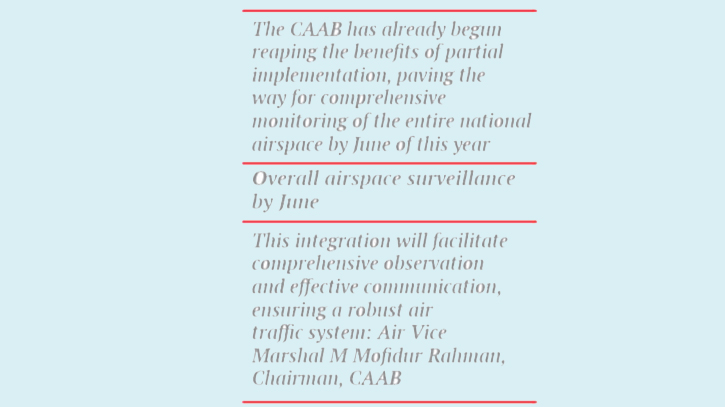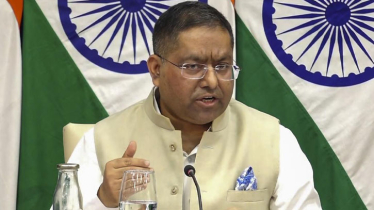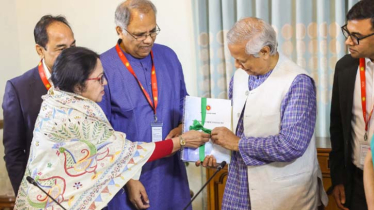
Photo : Messenger
Cutting-edge radar and navigation systems at Hazrat Shahjalal International Airport are on the verge of full operational deployment.
This technologically advanced system signifies the culmination of a significant upgrade, marking the retirement of a 43-year-old radar manufactured by the esteemed French company Thales, in an investment totaling approximately 650 crore taka. The Civil Aviation Authority (CABA) has already begun reaping the benefits of partial implementation, paving the way for comprehensive monitoring of the entire national airspace by June of this year.
According to reliable sources from CAAB, the implementation of the state-of-the-art radar system is poised to extend complete surveillance coverage over the airspace of Bangladesh, fostering a safer environment for air travel. This technological advancement is not only a boon for aviation safety but also holds promising financial benefits for the nation.
CAAB Chairman Air Vice Marshal M Mofidur Rahman, shared with media, "With just about 5 months remaining, we are on the verge of finalising the installation of the new radar." Rahman further explained that additional sensors are being integrated to complement existing radar systems, establishing a seamless coordination network. This integration will facilitate comprehensive observation and effective communication, ensuring a robust air traffic system. If the entire project is concluded by June, the overall quality of the air traffic management system is expected to witness a substantial improvement, minimising risks associated with air travel.
The current radar and navigation system, in operation for over four decades since the 1980s, is now considered outdated and inadequate. This obsolete system fails to provide comprehensive surveillance coverage over the entire airspace of the country, particularly in regions like the Bay of Bengal. This limitation not only compromises aviation safety but also has significant financial implications for Bangladesh.
Under existing regulations, there is a provision to levy fees, known as 'flying over charges,' on airlines from other countries utilising the airspace of Bangladesh. This fee, amounting to around $500 for a single use of the airspace, presents a considerable revenue-generating opportunity. However, the outdated radar system is incapable of detecting aircraft passing through these specific areas, resulting in missed opportunities to earn millions of dollars in revenue.
Speaking to The Daily Messenger Aviation expert Kazi Wahidul Alam highlighted the critical condition of the old radar, emphasising its loss of functionality and the inherent risk of accidents associated with its continued use. According to Alam, the imminent connection of the new radar system is poised to usher in a new era of smooth air traffic, mitigating potential risks and unlocking significant economic opportunities.
Alam pointed out that a substantial number of flights from both the east and west traverse through this region, flying over Bangladesh, particularly over the Bay of Bengal. The strategic installation of the latest technology in the radar system promises comprehensive coverage of these crucial airspaces. This, according to Alam, opens up the possibility of earning substantial foreign currency for the country, rectifying the missed opportunities of the past.
An official from Biman Bangladesh Airlines has disclosed that the existing radar system is plagued by functionality issues, leading to inadequate air traffic management. The system's inconsistent performance poses challenges in consistently detecting air traffic, impeding effective operations.
Pilots have expressed their concerns, noting that a significant number of flights often have to navigate landings without proper radar support. This absence of radar support results in prolonged landing times, highlighting the critical role radar plays in ensuring timely and efficient air traffic management. The current radar's limited range, monitoring airspace up to 200 nautical miles, further exacerbates the challenges faced by both airline officials and pilots.
The pilot community also raises a specific concern regarding flights operating at lower altitudes in the Bay of Bengal, suggesting that they can potentially evade the monitoring capabilities of the existing radar system.
The radar system from the 1980s has indeed reached the end of its operational life. The initiative to replace it with a new radar has been on the agenda since 2005, but, unfortunately, none of the attempts have materialised until now.
A notable development occurred when the Cabinet Committee on Economic Affairs approved a proposal to implement the radar project on March 1, 2017. The estimated cost of this project was 1,755 crores. However, this approval was met with criticism, particularly regarding concerns of overspending. Subsequently, the approval for the project was revoked.
The revocation of the approval underscores the challenges and debates surrounding the financial aspects of the radar project. It suggests that there have been discussions and disagreements regarding the budget allocation for the new radar system.
In a significant development in 2021, CAAB secured approval to proceed with the radar project using its own funding. The estimated expenditure for this initiative is around 730 crore taka, signaling a commitment to modernise and upgrade the existing radar infrastructure.
Furthermore, in October 2021, CAAB took a crucial step forward by entering into an agreement with the renowned French radar manufacturing company, Thales. The collaboration is aimed at implementing the project, specifically titled 'Radar installation including CNS-ATM (Communication, Navigation and Surveillance-Air Traffic Management) system at Hazrat Shahjalal International Airport.' This partnership underscores the reliance on Thales' expertise in radar technology to bring about a state-of-the-art system that integrates communication, navigation, and surveillance for effective air traffic management.
The historical context of Thales' involvement in Bangladesh's technological advancements is indeed noteworthy. Thales, a prominent French aerospace and defense company, has been instrumental in contributing to Bangladesh's technological landscape.
Firstly, Thales successfully built Bangladesh's inaugural satellite, 'Bangabandhu-1.' Launched in May 2018, this satellite marked a significant milestone for the country, providing communication and broadcasting services.
Messenger/Fameema








